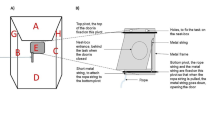Abstract
Social learning is considered one of the hallmarks of cognition. Observers learn from demonstrators that a particular behavior pattern leads to a specific consequence or outcome, which may be either positive or negative. In the last few years, social learning has been studied in a variety of taxa including birds and bony fish. To date, there are few studies demonstrating learning processes in cartilaginous fish. Our study shows that the cartilaginous fish freshwater stingrays (Potamotrygon falkneri) are capable of social learning and isolates the processes involved. Using a task that required animals to learn to remove a food reward from a tube, we found that observers needed significantly (P < 0.01) fewer trials to learn to extract the reward than demonstrators. Furthermore, observers immediately showed a significantly (P < 0.05) higher frequency of the most efficient “suck and undulation” strategy exhibited by the experienced demonstrators, suggesting imitation. Shedding light on social learning processes in cartilaginous fish advances the systematic comparison of cognition between aquatic and terrestrial vertebrates and helps unravel the evolutionary origins of social cognition.



Similar content being viewed by others
References
Bandura A (1969) Social-learning theory of identificatory processes. In: Goslin DA (ed) Handbook of socialization theory and research. Rand-McNally, Chicago, pp 213–262
Boyd R, Richerson PJ (1998) An evolutionary model of social learning: the effect of spatial and temporal variation. In: Zentall TR, Galef BG (eds) Social learning: psychological and biological perspectives. Erlbaum, New Jersey, pp 29–48
Brown C, Laland K, Krause J (2011) Fish cognition and behaviour. Wiley-Blackwell, Oxford. doi:10.1002/9781444342536
Byrne RW (2003) Imitation as behaviour parsing. Philos Trans R Soc Lond B Biol Sci 358:529–536
Davis KM, Burghardt GM (2011) Turtles (Pseudemys nelsoni) learn about visual cues indicating food from experienced turtles. J Comp Psych 125:404–410
Dorrance BR, Zentall TR (2001) Imitative learning in Japanese quail (Coturnix japonica) depends on the motivational state of the observer quail at the time of observation. J Comp Psych 115:62–67
Fiorito G, Scotto P (1992) Observational learning in Octopus vulgaris. Science 256:545–547
Guttridge TL, Dijk S, Stamhuis EJ, Krause J, Gruber SH, Brown C (2013) Social learning in juvenile lemon sharks, Negaprion brevirostris. Anim Cogn 16:55–64
Heyes CM (1994) Social learning in animals: categories and mechanisms. Biol Rev 69:207–231
Heyes CM (2009) Evolution, development and intentional control of imitation. Philos Trans R Soc Lond B Biol Sci 364:2293–2298
Hoppitt W, Laland N (2008) Social processes influencing learning in animals: a review of the evidence. Adv Stud Behav 38:105–165
Huber L, Range F, Voelkl B, Szucsich ZV, Miklosi A (2009) The evolution of imitation: what do the capacities of non-human animals tell us about the mechanisms of imitation? Philos Trans R Soc Lond B Biol Sci 364:2299–2309
Kuba MJ, Byrne RA, Burghardt GM (2010) A new method for studying problem solving and tool use in stingrays (Potamotrygon castexi). Anim Cogn 13:507–513
Leadbeater E, Chittka L (2007) Social learning in insects—from miniature brains to consensus building. Curr Biol 17:703–713
Slagsvold T, Wiebe KL (2011) Social learning in birds and its role in shaping a foraging niche. Philos Trans R Soc Lond B Biol Sci 366:969–977
Spence KW (1937) Experimental studies of learning and higher mental processes in infra-human primates. Psych Bul 34:806–850
Thorpe WH (1963) Learning and instinct in animals, 2nd edn. Methuen, London
Tomasello M, Kruger AC, Ratner HH (1993) Cultural learning. Behav Brain Sci 16:495–552
Wilkinson A, Kuenstner K, Mueller J, Huber L (2010) Social learning in a non- social reptile (Geochelone carbonaria). Biol Lett 6:614–616
Zentall TR (2006) Imitation: definitions, evidence, mechanisms. Anim Cogn 9:335–353
Acknowledgments
We gratefully acknowledge the Vienna Zoo for the experimental framework requirements and their support. Furthermore, we want to thank the animal keeper team in the Aquarium house who supported and enriched this project with their help and ideas. We especially would like to thank Prof. M. J. Gutnick for his critical review of the manuscript.
Author information
Authors and Affiliations
Corresponding author
Additional information
Kerstin E. Thonhauser and Tamar Gutnick: Equal contribution.
Electronic supplementary material
Below is the link to the electronic supplementary material.
Supplementary material 1 (MOV 25428 kb)
Rights and permissions
About this article
Cite this article
Thonhauser, K.E., Gutnick, T., Byrne, R.A. et al. Social learning in Cartilaginous fish (stingrays Potamotrygon falkneri). Anim Cogn 16, 927–932 (2013). https://doi.org/10.1007/s10071-013-0625-z
Received:
Revised:
Accepted:
Published:
Issue Date:
DOI: https://doi.org/10.1007/s10071-013-0625-z




